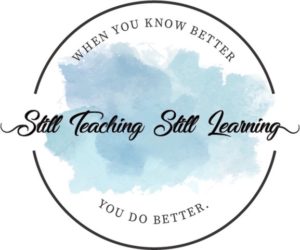
Student behavior is typically pretty good at the beginning of the year. Students are settling into a new classroom with a new teacher and possibly with different students in their class. Most things go fairly smoothly for the first few days. Some veteran teachers refer to this as the “honeymoon” period.
So what happens when the honeymoon is over?!
Any number of things. You might see more off-task behaviors, more “chattiness”, more neglectful or sloppy work, more defiance, more bullying or harassing behaviors.



What to do? Here are 13 tips.
1 – Review your expectations and your routines. You might even break it down to parts of your day, such as morning work, transitioning to literacy block, changing classes, transitioning to lunch, etc.
For each part of the day, list what you expect students to do. Make a checklist of these expectations and review with your students. You might get students to make a chart of these routines/expectations.
Another idea is to make Google slides of each of these parts of your day and display the slide during the appropriate part of the day. I’m working on doing that right now.
2 – Monitor during transitions to be sure that your expectations and routines are being followed. Redirect and remind those who are not following the expectation (by referring to the written list) and reinforce those who are doing it “right.”



3 – Put your discipline plan into action with as little emotion as possible. De-escalate situations by refusing to engage with the student when they are emotional. Simply state the expectation that the student is not meeting and remind them of what you expect them to be doing. If they fix it, fine. If not, they need to be removed from the source of the “fun” (go to “time out”, even if you don’t actually call it that). If it continues after those two chances to reset, they need to write a reflection of some sort. You might make a form for this and call it a “think sheet” or a “reflection.”
This written reflection should go home with the student to be signed by a parent or guardian. If the behavior continues, it’s time for you and the student to make a phone call to the parent/guardian. Have the student do most of the talking on the phone, explaining what the expectation is and what they are doing that is causing the problem.
After trying all of these steps, and if the behavior continues, it’s time for an office discipline referral.
Please note that all of these steps are for routine classroom discipline issues. If students are fighting, using profane or racist language, or if a student is so emotionally charged that they or others are in danger — that is an automatic call to the office for help.



4 – Have a private conversation with students who are having issues with behavior. Meet with them at a quiet moment, when other students are not around. Ask them questions about how things are going for them and ask if they are having any problems that you can help with. They may or may not open to you. After giving them a chance to talk, start a conversation about their problematic behaviors by telling them what you notice. Try not to sound accusatory — just an objective observer. Ask them what they notice. Many times, they will agree with you and say that they know they are doing these things as well. Then calmly explain to them why this behavior is a problem and how it is hurting them (not you). Ask if they have any ideas for how to solve the problem.



5 – Use dialogue journals to touch base with your students on a regular basis. In my classroom, students are allowed to write to me in their journal any time they want. I do set aside time on Fridays for them to write, just to ensure that everyone truly had a chance to tell me whatever they want me to know. I then write back to students, usually writing in about five journals a day. Here is a link to my post with more about these journals.
6 – Implement morning meeting or restorative practices circles. While nothing works overnight, this practice will ultimately be a game-changer in your classroom. It is a proactive way to help all students feel “seen” and feel a sense of belonging to a classroom community. When anyone feels connected to a community, they tend to want to act in ways that protect that community.



7 – Change their seats. Especially if they have been in the same spots since the beginning of the year. I typically change seats about once a month. For students who have been following expectations, I try to seat them with at least one of their friends. (Although sometimes the reason they have been following expectations is that they are NOT sitting with their friends — use your best judgment!)
8 – Continue to look for ways to connect with every student. Use restorative practices circles. Find a moment or two in the day to speak to a child about something you know about them (how their sport participation is going, how their pet is doing, how a family member is doing, etc.). Pull them aside to tell them something you appreciate about them or something positive you noticed that they are doing.



9 – Greet students at the door daily. This makes such a huge difference in making every student feel “seen” and cared for. It also helps you to gauge the student’s mood and feelings before the day begins.
10 – Say goodbye at the door daily, for the same reasons! Even if the day was not a positive one for the child, touching base as you say goodbye helps remind them that you care about them and that tomorrow is another day and with another chance for a fresh start.



11 – Make a kid notebook — use a binder or a simple notebook with a page for every child in your class. Just list bullet points of what you notice about individual students. If you have your students share things about themselves early in the year as a way of getting to know each other, jot down notes about what they share. This gives you a lot of information about your students’ interests and great ideas for how to incorporate their interests into your planning.
If you want to take this a step further, you could “kid watch” four or five of your students every day. I jot down their names on a sticky note and attach it to the clipboard that holds my daily plans. Throughout the day, I watch those particular students more closely and jot down some noticings, also on sticky notes. (I think that I personally keep the sticky note manufacturers in business.) I can then transfer those sticky notes to my kid notebook. Every two or three weeks, I scan through my kid notebook and reread notes I’ve made and add more notes if needed. This really helps me stay on top of what is going on with all of my students, not just the ones who “ask” for attention.



12 – Daily Check-ins — If you have “morning work” time in your schedule, consider creating a daily check-in. Some teachers make paper copies of this (you can print two of these on each page), but I prefer using a Google form. This sends data to a spreadsheet and allows me to see students’ feedback at a glance. Here is a link to a sample form.



13 – Monthly or Quarterly Check-ins — At least once a quarter (or maybe once a month), try giving your students a survey to check in on how everything is going for them. This gives them a chance to give you feedback and allows you to make changes that will benefit all of your students. I always get a lot of information from these surveys that I might not otherwise have known. I use this survey from Jennifer Gonzalez at Cult of Pedagogy.
Nothing works all the time or with every student. But I hope that at least one of these tips will be helpful to you. I’d love to hear your ideas!
